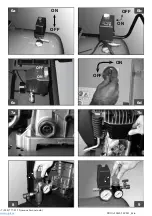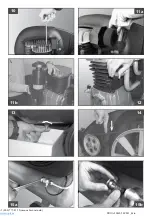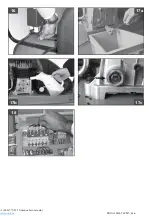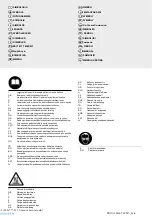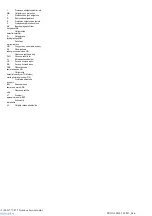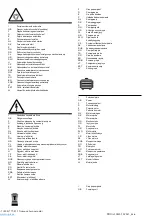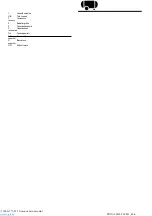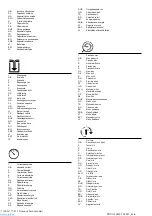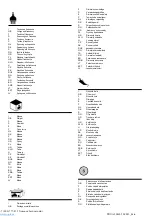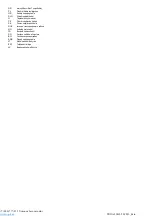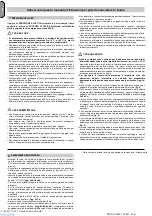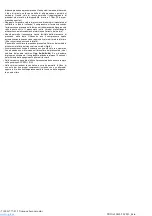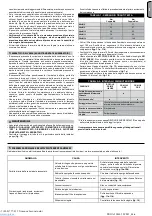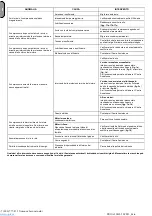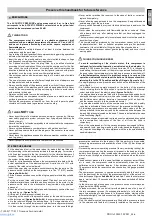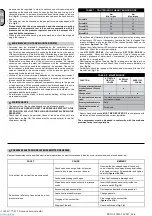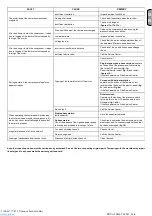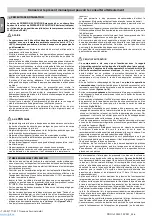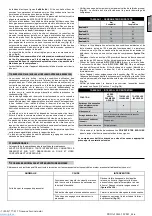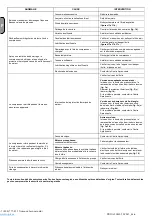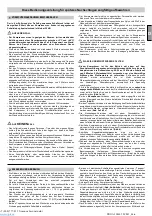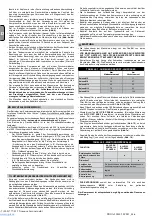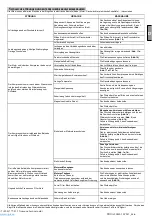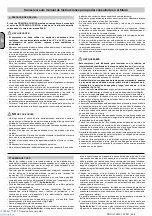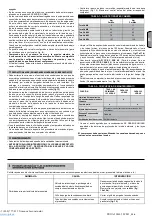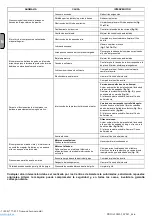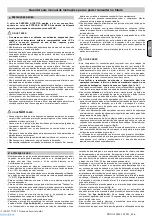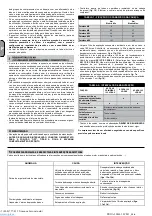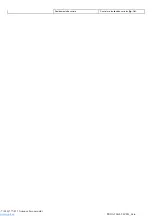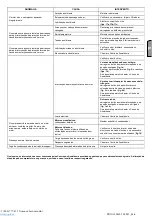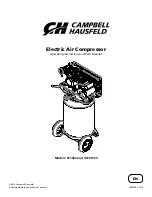
+7 (800) 777-83-75(звонок бесплатный)
1
PRECAUTIONS
The ACOUSTIC
PRESSURE’s value measured at 4 m in free field
corresponds to the ACOUSTIC POWER’s value stated on the yellow label
located on the compressor, minus 20 dB.
THINGS TO DO
•
The compressor must be used in a suitable environment (well
ventilated with an ambient temperature of b5°C and +40°C)
and never in places affected by dust, acids, vapors, explosive or
flammable gases
.
• Always maintain a safety distance of at least 4 meters between the
compressor and the work area.
• Any coloring of the belt guards of the compressor during painting operations
indicates that the distance is too short.
• Insert the plug of the electric cable in a socket of suitable shape, voltage
and frequency complying with current regulations.
• For 3-phase versions, have the plug fitted by a qualified electrician
according to local regulations. When starting the compressor for the first
time, check the correct direction of rotation and that this matches the
direction indicated by the arrow on the belt guard (versions with plastic
protection) or on the motor (versions with metal protection).
• Use extension cables with a maximum length of 5 meters and of suitable
cross-section.
• The use of extension cables of different length and also of adapters and
multiple sockets should be avoided.
• Always use the switch of the pressure switch to switch off the compressor
or use the switch of the electric panel for models equipped with this. Never
switch off the compressor by pulling out the plug in order to avoid restart
with pressure in the head.
• Always use the handle to move the compressor.
• When operating, the compressor must be placed on a stable, horizontal
surface to guarantee correct lubrication.
• Position the compressor at least 50 cm from the wall to permit optimal
circulation of fresh air and to guarantee correct cooling.
THINGS
NOT
TO DO
• Never direct the jet of air towards persons, animals or your body. (Always
wear safety goggles to protect your eyes from flying objects that may be
lifted by the jet).
• Never direct the jet of liquids sprayed by tools connected to the compressor
towards the compressor.
• Never use the appliance in your bare feet or with wet hands or feet.
• Never pull the power cable to pull the plug out of the socket or to move the
compressor.
• Never leave the appliance exposed to adverse weather conditions (rain,
sun, fog, snow).
• Never transport the compressor with the reservoir pressurized
2
START-UP AND USE
• Fit the wheels and foot (or the caster wheel for models that are fitted with
this) according to the instructions provided in the packaging. For versions
with fixed feet, assemble the front bracket kit or the vibration-dampers if
furnished. Check that the rating data match the effective characteristics of
the system (voltage and power).
• Check for correspondence between the compressor plate data with the
actual specifications of the electrical system. A variation of ± 10% with
respect of the rated value is allowed.
• Insert the power plug in a suitable socket checking that the button of the
pressure s
witch located on the compressor is in the “O” (OFF) position
(
figures 6a-6b-6c-6d
).
• For the 3-phase versions, connect the plug to a panel protected by suitable
fuses.
• For the versions fitted with electric panel (“Tandem” control units or
delta/star starters) have installation and connections (to the motor, to the
pressure switch and to the electrovalve if any) carried out by qualified
personnel.
• Check the oil level using the sight glass and if necessary unscrew the vent
plug and top up. (
figures 7a-7b
).
• At this point, the compressor is ready for use.
• Operating on the switch of the pressure switch (or the selector for versions
with electric panel, (
figures 6a-6b-6c-6d
), the compressor starts, pumping
air in the reservoir through the delivery hose. On 2-stage versions, air is
sucked in to the so-called low pressure cylinder liner and precompressed.
It is then routed, through the recirculation hose, into the so-called high
• Never weld or machine the reservoir. In the case of faults or corrosion,
G
replace it completely.
• Never allow inexpert persons to use the compressor. Keep children and
animals away from the work area.
• Never position flammable or nylon or fabric articles close to and/or on the
compressor.
• Never clean the compressor with flammable liquids or solvents. Clean
with a damp cloth only, after making sure that you have unplugged the
compressor.
• The compressor is designed only to compress air and must not be used for
any other type of gas.
• The compressed air produced by the compressor cannot not be used
for pharmaceutical, food or hospital purposes except after particular
treatments. It is not suitable for filling the air bottles of scuba divers.
• Never use the compressor without guards (belt guard) and never touch
moving parts.
THINGS YOU SHOULD KNOW
•
To avoid overheating of the electric motor, this compressor is
designed for intermittent operation as indicated on the dataplate
(for
example, S3-50 means 5 minutes ON and 5 minutes OFF). In the case of
overheating, the thermal cutout of the motor trips, automatically cutting off
the power when the temperature is too high due to excess current take- off.
•
To facilitate machine restart, it is important not only to carry out the
operations indicated but also to set the button of the pressure switch,
returning this to the OFF position and then ON again (figures 1a-1b).
• On single-phase versions, press the reset button on the terminal box of the
motor (
fig. 2
).
• On 3-phase versions, operate manually on the button of the pressure
switch, returning this to the ON position, or press the button of the thermal
cutout inside the box of the electric panel (
figures 3a-3b-3c
).
• The single-phase versions are fitted with a pressure switch equipped with
a delayed closing air vent valve (or with a valve located on the check valve)
that facilitates motor start-up; therefore a few-second jet of air from this,
with the reservoir empty, is to be considered normal.
• To guarantee machine safety, all the compressors are fitted with a safety
valve that is activated in the case of failure of the pressure switch (
fig. 4
).
• All two-stage compressors are equipped with safety valves on the air
delivery manifold to the reservoir and on the connection hose between the
low and high pressure located on the head. These are activated in the case
of malfunctioning (
fig. 5
).
• When connecting an air-powered tool to a hose of compressed air supplied
by the compressor, interruption of the flow of air from the hose is
compulsory.
• Use of the compressed air for the various purposes envisaged (inflation,
air-powered tools, painting, washing with water-based detergents only,
etc.) requires knowledge of and compliance with the rules established for
each individual use.
pressure liner and then into the reservoir. With this work cycle, it is possible
to reach higher pressure, with availability of air at 11 bar (15 bar for special
machines).
• On reaching maximum operating pressure (factory-set during testing), the
compressor stops, venting the excess air present in the head and in the
delivery hose through a valve located under the pressure switch (in delta/
star versions, through an electrovalve that is activated when the motor
stops).
•The absence of pressure in the head facilitates subsequent restart. When
air is used, the compressor restarts automatically when the lower
calibration value is reached (approx. 2 bar between upper and lower).
The pressure inside the reservoir can be checked on the gauge provided
(
fig. 4
).
• The compressor continues to operate automatically with this work cycle
until the position of the switch of the pressure switch (or of the selector of
the electric panel) figures
6a-6b-6c-6d
) is modified. To use the compressor
again, wait at least 10 seconds after this has been switched off before
restarting.
• In the versions with electric panel, the pressure switch must always be
aligned with the
I
(
ON
) position.
• In tandem versions, the control unit provided permits use of only one of
the two compressor groups (if necessary alternatively) or of both at the
same time according to requirements. In this second case, start-up will be
differentiated slightly to avoid excessively high current take-off at start-up
(timed starting).
• Only the wheel-mounted compressors are fitted with a pressure reducer
(in the versions with fixed feet, it is usually installed on the use line). Air
Preserve this handbook for future reference
B
Summary of Contents for PRO A29B-0 50 CM3 Zero
Page 4: ...7 800 777 83 75 www v p k ru PRO A29B 0 50 CM3_Zero 1a 1b 2 3b 3c 4...
Page 6: ...7 800 777 83 75 www v p k ru PRO A29B 0 50 CM3_Zero 10 11a 11b 12 13 14 15a 15b...
Page 7: ...7 800 777 83 75 www v p k ru PRO A29B 0 50 CM3_Zero 18 16 17a 17b 17c...
Page 84: ...7 800 777 83 75 www v p k ru PRO A29B 0 50 CM3_Zero 16...
Page 100: ...7 800 777 83 75 www v p k ru PRO A29B 0 50 CM3_Zero Single phase Three phase Three phase...

